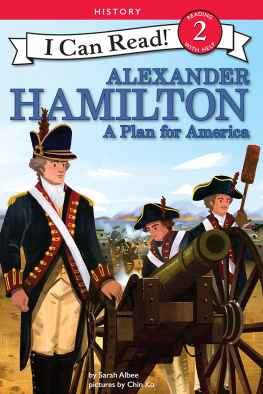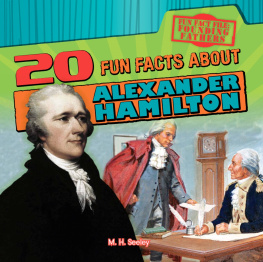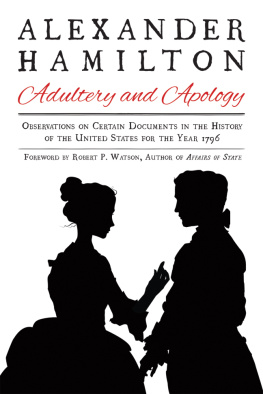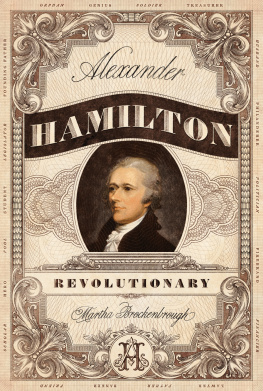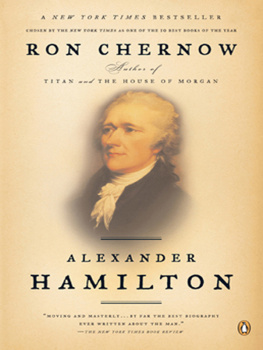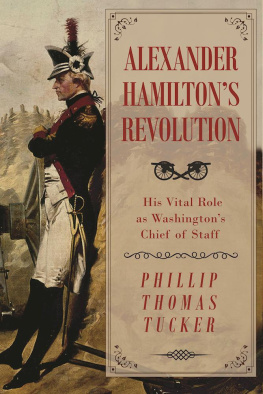
First published in 1910 by Charles Scribners Sons
First Racehorse Publishing Edition 2016
All rights to any and all materials in copyright owned by the publisher are strictly reserved by the publisher.
Foreword 2016 Willard Sterne Randall
Racehorse Publishing books may be purchased in bulk at special discounts for sales promotion, corporate gifts, fund-raising, or educational purposes. Special editions can also be created to specifications. For details, contact the Special Sales Department, Skyhorse Publishing, 307 West 36th Street, 11th Floor, New York, NY 10018 or .
Racehorse Publishing is a pending trademark of Skyhorse Publishing, Inc., a Delaware corporation.
Visit our website at www.skyhorsepublishing.com.
10 9 8 7 6 5 4 3 2 1
Library of Congress Cataloging-in-Publication Data is available on file.
Print ISBN: 978-1-944686-39-0
Ebook ISBN: 978-1-944686-41-3
Printed in the United States of America

JOHN HOWARD VAN AMRINGE
PROFESSOR OF MATHEMATICS AND DEAN OF
COLUMBIA UNIVERSITY
AND FOR FIFTY YEARS IDENTIFIED THEREWITH ; WHO DURING
ALL THIS TIME HAS DONE SO MUCH TO
PERPETUATE THE MEMORY OF
ALEXANDER HAMILTON
AND TO INCULCATE AMONG THE STUDENTS AND ALUMNI OF
HIS ALMA MATER , A REVERENCE FOR HIS NAME AND
AN APPRECIATION OF HIS VIRTUES
CONTENTS
ILLUSTRATIONS
Alexander Hamilton at 37
From the painting by James Sharpless
West End, St. Croix
From a painting by Ralph Earle in 1787
Elizabeth Hamilton: Age 94
From a charcoal sketch by Martin, 1851
From an engraved portrait by St. Memin
From a painting by John Trumbull
The Grangeabout 1864
Aaron Burr
From an engraved portrait by St. Memin
From the painting by John Trumbull, 1792
FOREWORD
T HE LEAD BALL that ended Alexander Hamiltons life very nearly obliterated his place in the American pantheon as the brilliant founder of the American financial system. But even before the July dawn in 1804 when he faced Aaron Burr in a duel, the flamboyant first US secretary of the treasury had forged and shattered crucial collaborations with nearly every other Founding Father.
Chief aide-de-camp and legal adviser to Revolutionary War commander in chief George Washington, architect of the Constitution with James Madison and his coauthor in the Federalist Papers, it was Hamilton and his Cabinet colleague, Thomas Jefferson, who had struck the compromise that selected Washington, DC, as the site of the nations capital. After his bitter rivalry with Jefferson induced a reluctant President Washington to accept a second term, Hamilton sided with John Adams in the bitter political struggle with Jefferson and Madison that produced the two-party system, something not envisioned in the nations foundation documents. Then, when Hamilton undercut Adamss chances for reelection to a second term, the Boston Brahmin branded him the bastard brat of a Scots pedlar, a damning double curse in Puritanand commercialNew England. But it was Hamiltons dinner table description of Vice President Burr, once his fellow law student and cofounder of Tammany Hall, as untrustworthy that triggered the fatal face-off on the narrow bluff at Weehawken.
As his nineteenth-century historian Henry Cabot Lodge phrased it, Hamiltons great contemporary reputation suffered after his death an almost complete eclipse. The success of the expansionist course chosen by Jefferson and Madison, his chief opponents, in purchasing the vast Louisiana Territory and waging the War of 1812coupled with the utter failure of Hamiltons party to resist themthat caused Hamiltons Federalist Party to sink and his fame along with it.
Even scholars ceased to study his contributions in the first half of the nineteenth century. Only his highly partisan son, John Church Hamilton, attempted to cobble his fathers papers into a biography that not only failed to preserve Hamiltons reputation but introduced a plethora of errors into the historical record.
Lodge, recipient of the first PhD in history from Harvard University, argued in 1886 in the preface to the twelve-volume Works of Alexander Hamilton that the great ordeal by fire of the Civil War awakened Americans, especially Northerners. They began to realize the greatness of Hamiltons work and the meaning and power of the nation Hamilton had helped to build. Symbolizing if not encouraging this rebirth was Hamiltons appearance on the $2 bill as the first Greenbacks replaced scarce hard money in 1862. After the Civil War, schools, universities, and the newly minted graduate schools began to teach American history as never before, exploring every nook and corner of our history.
No one profited more, Lodge asserted, than Hamilton. The first edition of five hundred copies of Lodges Works sold out quickly. By the time he published a second edition eighteen years later on the centenary of Hamiltons death, a host of novels had romanticized his life and death. Hamilton continued to loom ever larger. By the turn of the twentieth century, more and more events had justified Hamiltons conception of American government, the soundness of his finance silently accepted.
Yet Lodges multi-tome compendium, while illustrating Hamiltons fluency, remained lifeless. Resulting gaps and errata prompted Hamiltons grandson, Allan McLane Hamilton, to blow the dust off bales of family papers and produce this volume, The Intimate Life of Alexander Hamilton , its pages embellished for the first time with photographs. And what photographs! The counting house in Saint Croix where teenage Hamilton learned how to keep ledgers, wash down slaves newly arrived from Africa for auctioning off, and give orders to ships captains when he was only seventeen. The dueling pistols borrowed from the husband of Hamiltons lover, his sister-in-law Angelica, lie in their case near the portrait of Hamiltons own eldest son, killed in a duel while clenching one of the hair-triggered weapons.
The 1910 Intimate Life depended on hundreds of family letters and accounts, documenting Hamiltons prodigious labors and explaining not only his accomplishments but also his failures. But the book opens with a flaw that runs like a fault line all the way through it. As later research would reveal, it did not correct Lodges earlier error: Alexander Hamilton was born on January 11, 1755, not 1757, a not-insignificant fact. So long admired for his supposed precocity, Hamilton often had suffered resentment for the same reason.
Hamilton was born in the British colony of Nevis, in the Caribbean. His mother, Rachel Fawcett, daughter of a Huguenot refugee, was married at sixteen to Johann Levine, a much older German Jewish merchant-planter. He thought she had money; her mother thought he did. As he ran through her dowry and went ever deeper into debt, Levine abused Rachel. After they had a child, Peter, Levine had Rachel imprisoned for refusing his connubial rights. She fled to her family on the nearby Danish island of Saint Croix. Three years later, Rachel began a common-law relationship with James Hamilton, impecunious fourth son of a wealthy Scottish laird. Under the English law of primogeniture and entail, only the firstborn son inherited. James was apprenticed to a Glasgow linen trading firm. He sailed for the Caribbean just as the linen market collapsed.
Drifting from island to island, the Hamiltons, as they signed themselves in Anglican church records, had two sons. Alexander, the elder, was nine when his parents learned that, after a twelve-year separation, Levine, intending to remarry, had divorced her on grounds of adultery and desertion. Under Danish law, he could divorce her; under English law, she could not divorce. Under Danish law, he could remarry; under Danish law, she could not. To spare Rachel a charge of bigamy, James Hamilton sailed away. From that day on, Alexander Hamilton was considered a bastard. He never saw his father again.
Next page
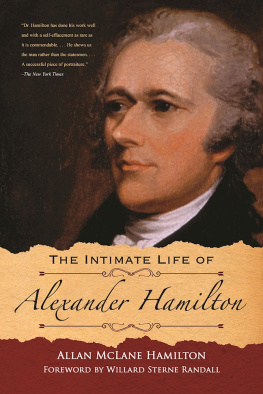
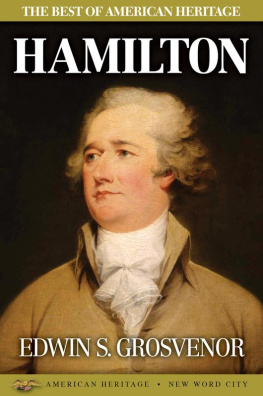

![A. K. ]]> - Rough Diamond: The Life of Colonel William Stephen Hamilton, Alexander Hamiltons Forgotten Son](/uploads/posts/book/377309/thumbs/a-k-rough-diamond-the-life-of-colonel.jpg)
